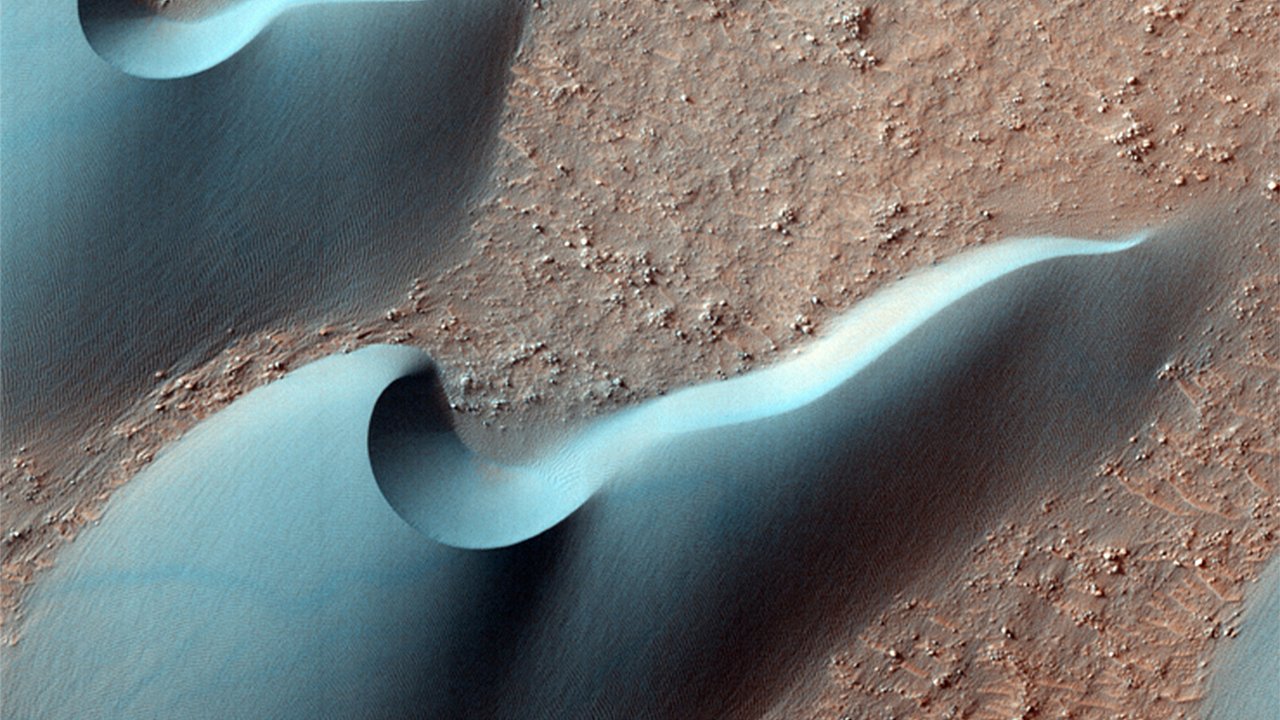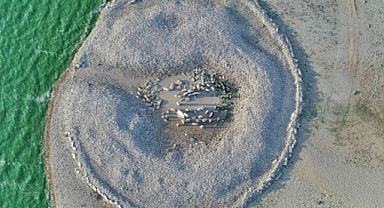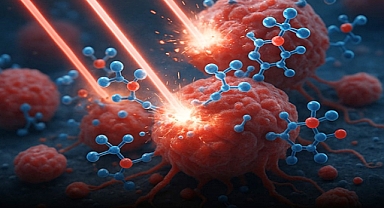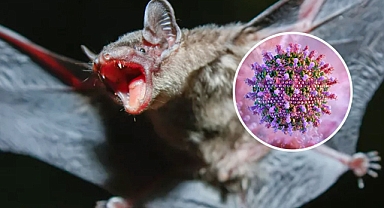A Striking New Look at the Martian Surface
If you’re searching for breathtaking landscapes and unparalleled solitude, look no further than the surface of Mars.While often called the Red Planet, Mars boasts a more diverse and colorful landscape than its nickname suggests. Thanks to the High-Resolution Imaging Science Experiment (HiRISE) camera aboard NASA’s Mars Reconnaissance Orbiter (MRO), scientists and space enthusiasts alike can witness the planet’s terrain in an array of striking hues.For over a decade, HiRISE has been capturing scientifically invaluable and visually stunning images, revealing details as small as a few feet across. These ultra-high-resolution photos allow researchers to study Mars' geology, monitor seasonal changes, and even document the impact of past missions—such as the crash site of the European Space Agency’s Schiaparelli lander.NASA has recently released 2,540 new images, taken between August and October, showcasing Mars in breathtaking clarity. We’ve explored 2,054 of these remarkable shots to bring you a selection of the most awe-inspiring views—offering you a temporary escape from Earth’s confines and a glimpse into the mysterious beauty of our neighboring planet.
 NASA/JPL/University of ArizonaNASA might land its next nuclear-powered Mars 2020 rover mission here.
NASA/JPL/University of ArizonaNASA might land its next nuclear-powered Mars 2020 rover mission here.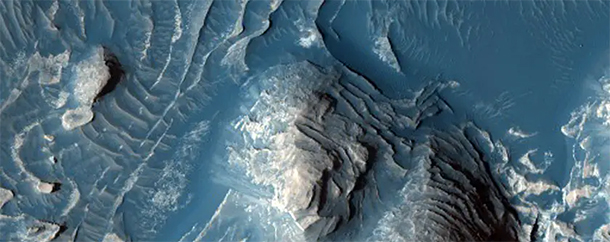 NASA/JPL/University of ArizonaThe black splotch is where the European Space Agency’s Schiaparelli Mars lander crashed. The white specks, pointed out with arrows, are pieces of the lander.
NASA/JPL/University of ArizonaThe black splotch is where the European Space Agency’s Schiaparelli Mars lander crashed. The white specks, pointed out with arrows, are pieces of the lander.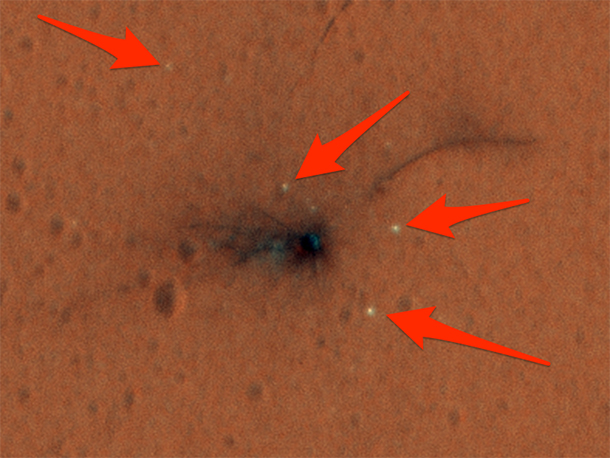 NASA/JPL-Caltech/University of Arizona; Business InsiderRead more about the accident here. Zebra skin. Just kidding, this is a dune field that’s speckled with oval-shaped mineral deposits:
NASA/JPL-Caltech/University of Arizona; Business InsiderRead more about the accident here. Zebra skin. Just kidding, this is a dune field that’s speckled with oval-shaped mineral deposits: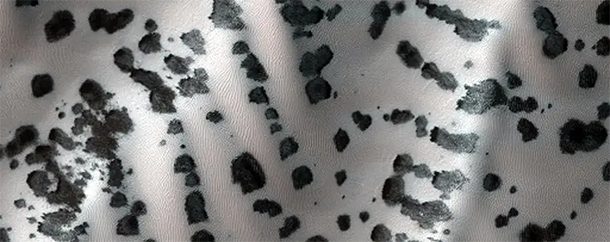 NASA/JPL/University of ArizonaFalse-coloring this image makes a giant dune and its gullies look blue.
NASA/JPL/University of ArizonaFalse-coloring this image makes a giant dune and its gullies look blue.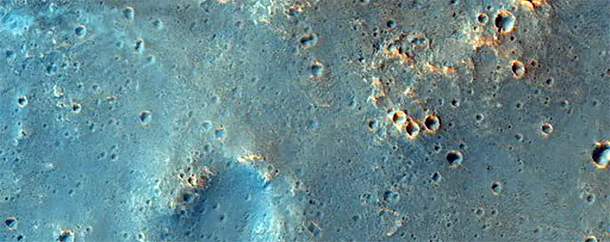 NASA/JPL/University of ArizonaA North Pole dune field nicknamed “Kolhar,” after Frank Herbert’s fictional world.
NASA/JPL/University of ArizonaA North Pole dune field nicknamed “Kolhar,” after Frank Herbert’s fictional world.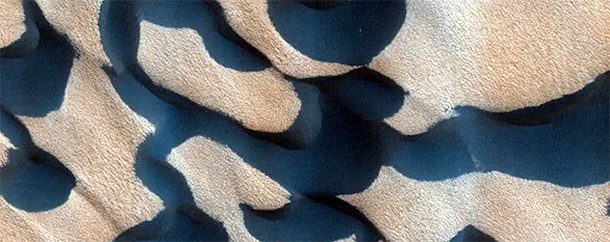 NASA/JPL/University of ArizonaCarbon dioxide that turns from solid to gas carves out these strange shapes at Mars’ south pole:
NASA/JPL/University of ArizonaCarbon dioxide that turns from solid to gas carves out these strange shapes at Mars’ south pole: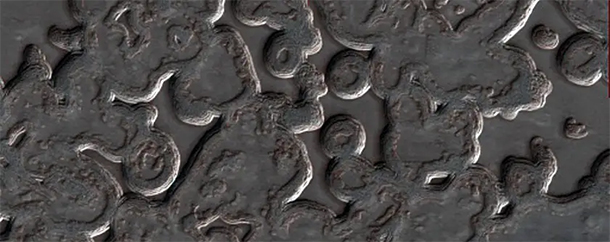 NASA/JPL/University of ArizonaA recent impact crater on Mars. (We’re pretty sure no one put out a giant cigarette here.)
NASA/JPL/University of ArizonaA recent impact crater on Mars. (We’re pretty sure no one put out a giant cigarette here.)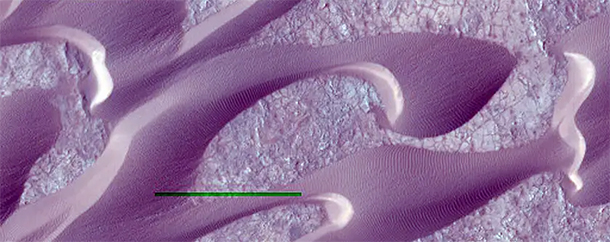 NASA/JPL/University of ArizonaThe same sand dunes in full color, a couple of months later:
NASA/JPL/University of ArizonaThe same sand dunes in full color, a couple of months later: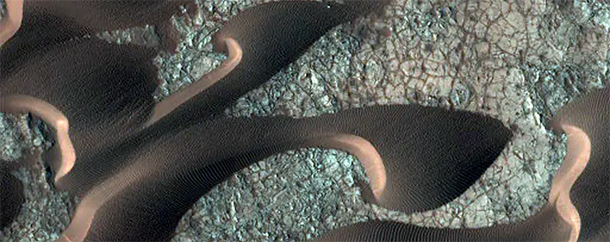 NASA/JPL/University of ArizonaThe creation of ‘fans’ around dunes may help scientists understand seasonal changes on Mars:
NASA/JPL/University of ArizonaThe creation of ‘fans’ around dunes may help scientists understand seasonal changes on Mars: NASA/JPL/University of ArizonaAnother possible landing site for the Mars 2020 mission:
NASA/JPL/University of ArizonaAnother possible landing site for the Mars 2020 mission: NASA/JPL/University of ArizonaTerrain near the Martian equator:
NASA/JPL/University of ArizonaTerrain near the Martian equator: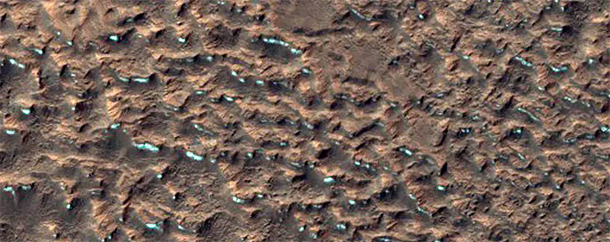 NASA/JPL/University of ArizonaCeraunius Fossae is a region dominated by volcanic flows and large cracks:
NASA/JPL/University of ArizonaCeraunius Fossae is a region dominated by volcanic flows and large cracks: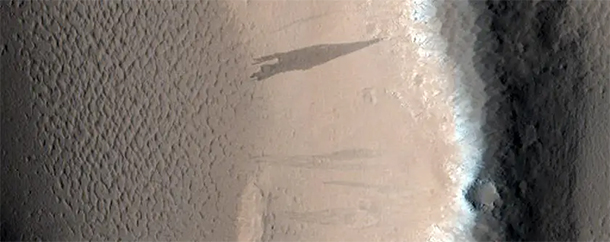 NASA/JPL/University of ArizonaBeautiful texture in the region called North Sinus Meridiani:
NASA/JPL/University of ArizonaBeautiful texture in the region called North Sinus Meridiani: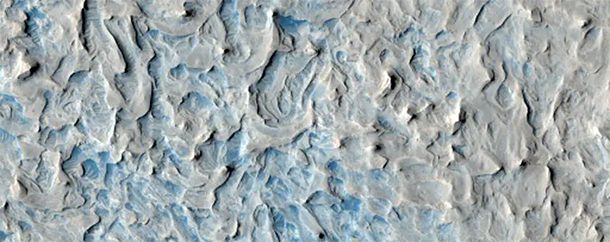 NASA/JPL/University of ArizonaFalse colours assigned to certain minerals make Syria Planum an inky blue that’s speckled with gold:
NASA/JPL/University of ArizonaFalse colours assigned to certain minerals make Syria Planum an inky blue that’s speckled with gold: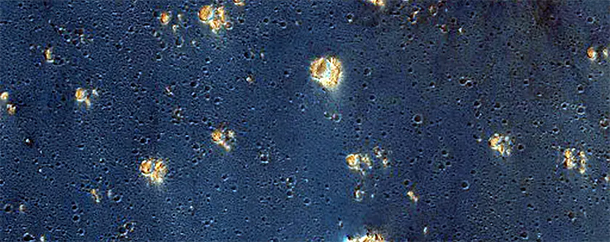 NASA/JPL/University of ArizonaA crater on Arcadia Planitia, a large flat region of Mars:
NASA/JPL/University of ArizonaA crater on Arcadia Planitia, a large flat region of Mars: NASA/JPL/University of ArizonaLayers in Martian buttes found in a region called West Arabia:
NASA/JPL/University of ArizonaLayers in Martian buttes found in a region called West Arabia: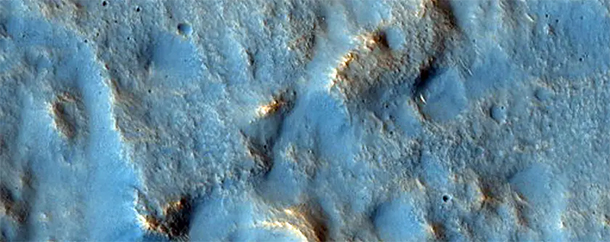 NASA/JPL/University of ArizonaA bright speckle of minerals stands out on Galle (not Gale) Crater:
NASA/JPL/University of ArizonaA bright speckle of minerals stands out on Galle (not Gale) Crater: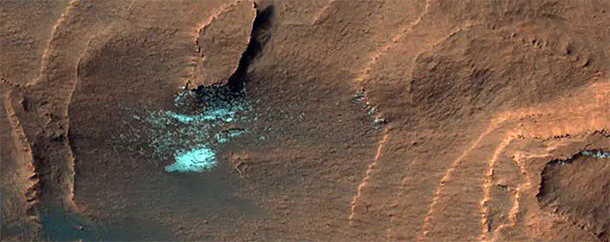 NASA/JPL/University of ArizonaA small but recent impact crater:
NASA/JPL/University of ArizonaA small but recent impact crater: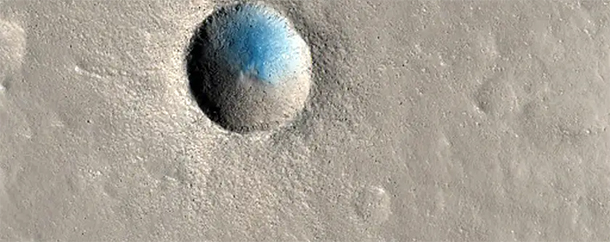 NASA/JPL/University of ArizonaBlowing sand eats through the rims of older craters:
NASA/JPL/University of ArizonaBlowing sand eats through the rims of older craters: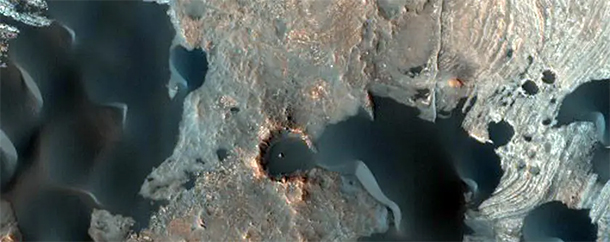 NASA/JPL/University of ArizonaMars in all its two-toned glory:
NASA/JPL/University of ArizonaMars in all its two-toned glory: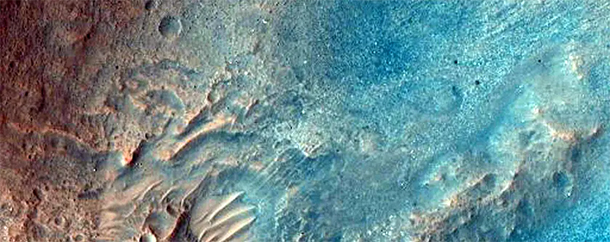 NASA/JPL/University of ArizonaSeasonal dunes on Mars nicknamed ‘Buzzel’.
NASA/JPL/University of ArizonaSeasonal dunes on Mars nicknamed ‘Buzzel’. NASA/JPL/University of ArizonaRidges cross the Nepenthes Mensae region, which is often referred to as a river delta for the striking pattern:
NASA/JPL/University of ArizonaRidges cross the Nepenthes Mensae region, which is often referred to as a river delta for the striking pattern: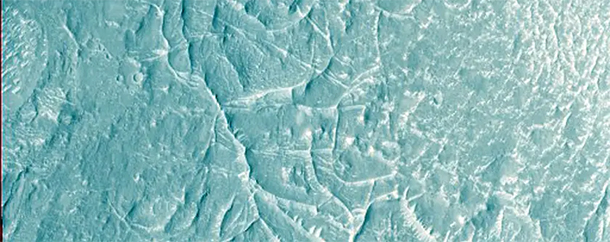 NASA/JPL/University of ArizonaThe edges of a debris apron, where cliff material eroded away.
NASA/JPL/University of ArizonaThe edges of a debris apron, where cliff material eroded away.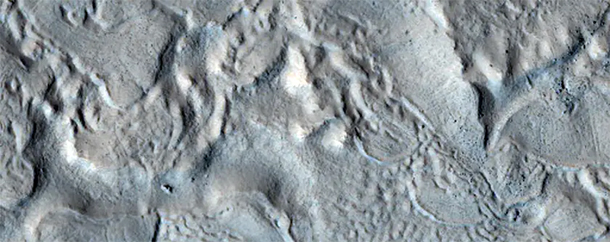 NASA/JPL/University of ArizonaAlluvial fans are some of the evidence that scientists used to confirm there was once water on Mars.
NASA/JPL/University of ArizonaAlluvial fans are some of the evidence that scientists used to confirm there was once water on Mars.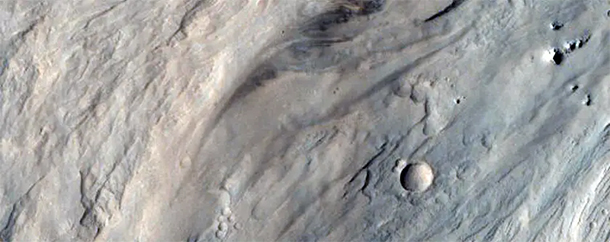 NASA/JPL/University of ArizonaExposed bedrock on the Capri Chasma, which may once have been filled with floodwaters:
NASA/JPL/University of ArizonaExposed bedrock on the Capri Chasma, which may once have been filled with floodwaters: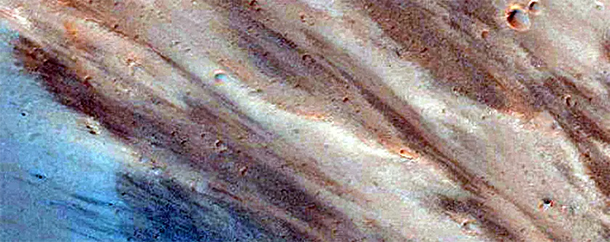 NASA/JPL/University of ArizonaThis is the edge of a special layered deposit at Mars’ south pole.The false-colour makes the white look like ice, but it’s just one of the many layers of rock and soil.
NASA/JPL/University of ArizonaThis is the edge of a special layered deposit at Mars’ south pole.The false-colour makes the white look like ice, but it’s just one of the many layers of rock and soil. NASA/JPL/University of ArizonaThe shadow of Ganges Chasma looms tall:
NASA/JPL/University of ArizonaThe shadow of Ganges Chasma looms tall: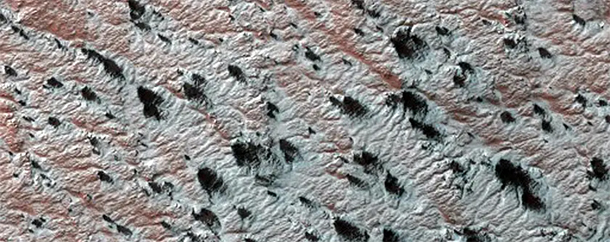 NASA/JPL/University of Arizona
NASA/JPL/University of Arizona
We wouldn’t want to get lost in the dune fields of Amazonis Planitia.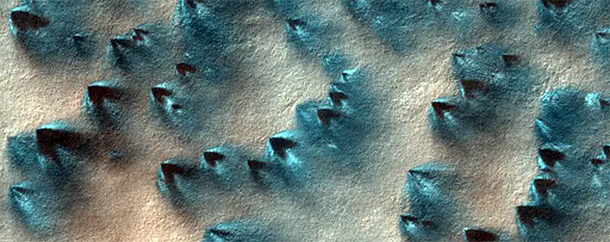 NASA/JPL/University of Arizona
NASA/JPL/University of Arizona
A pair of collapse pits in Ceraunius Fossae.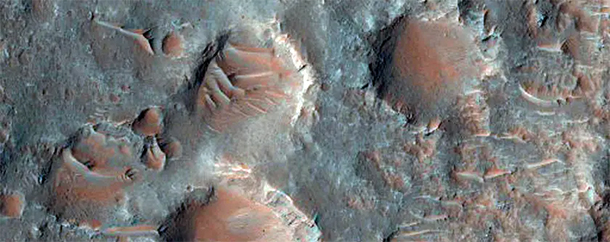 NASA/JPL/University of ArizonaMawrth Vallis, another ancient location that NASA is eyeing for landing the Mars 2020 rover.
NASA/JPL/University of ArizonaMawrth Vallis, another ancient location that NASA is eyeing for landing the Mars 2020 rover.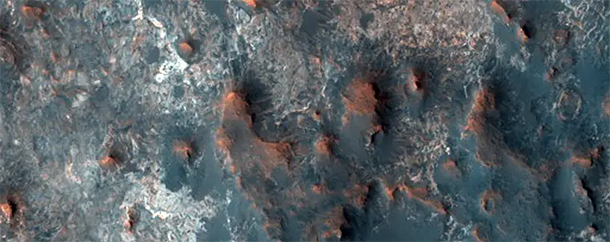 NASA/JPL/University of Arizona
NASA/JPL/University of Arizona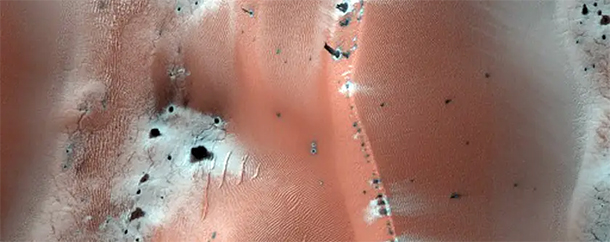 NASA/JPL/University of ArizonaDefrosting dry ice makes these strange patterns in the ground.
NASA/JPL/University of ArizonaDefrosting dry ice makes these strange patterns in the ground.
If you’re searching for breathtaking landscapes and unparalleled solitude, look no further than the surface of Mars.While often called the Red Planet, Mars boasts a more diverse and colorful landscape than its nickname suggests. Thanks to the High-Resolution Imaging Science Experiment (HiRISE) camera aboard NASA’s Mars Reconnaissance Orbiter (MRO), scientists and space enthusiasts alike can witness the planet’s terrain in an array of striking hues.For over a decade, HiRISE has been capturing scientifically invaluable and visually stunning images, revealing details as small as a few feet across. These ultra-high-resolution photos allow researchers to study Mars' geology, monitor seasonal changes, and even document the impact of past missions—such as the crash site of the European Space Agency’s Schiaparelli lander.NASA has recently released 2,540 new images, taken between August and October, showcasing Mars in breathtaking clarity. We’ve explored 2,054 of these remarkable shots to bring you a selection of the most awe-inspiring views—offering you a temporary escape from Earth’s confines and a glimpse into the mysterious beauty of our neighboring planet.
 NASA/JPL/University of ArizonaNASA might land its next nuclear-powered Mars 2020 rover mission here.
NASA/JPL/University of ArizonaNASA might land its next nuclear-powered Mars 2020 rover mission here. NASA/JPL/University of ArizonaThe black splotch is where the European Space Agency’s Schiaparelli Mars lander crashed. The white specks, pointed out with arrows, are pieces of the lander.
NASA/JPL/University of ArizonaThe black splotch is where the European Space Agency’s Schiaparelli Mars lander crashed. The white specks, pointed out with arrows, are pieces of the lander. NASA/JPL-Caltech/University of Arizona; Business InsiderRead more about the accident here. Zebra skin. Just kidding, this is a dune field that’s speckled with oval-shaped mineral deposits:
NASA/JPL-Caltech/University of Arizona; Business InsiderRead more about the accident here. Zebra skin. Just kidding, this is a dune field that’s speckled with oval-shaped mineral deposits: NASA/JPL/University of ArizonaFalse-coloring this image makes a giant dune and its gullies look blue.
NASA/JPL/University of ArizonaFalse-coloring this image makes a giant dune and its gullies look blue. NASA/JPL/University of ArizonaA North Pole dune field nicknamed “Kolhar,” after Frank Herbert’s fictional world.
NASA/JPL/University of ArizonaA North Pole dune field nicknamed “Kolhar,” after Frank Herbert’s fictional world. NASA/JPL/University of ArizonaCarbon dioxide that turns from solid to gas carves out these strange shapes at Mars’ south pole:
NASA/JPL/University of ArizonaCarbon dioxide that turns from solid to gas carves out these strange shapes at Mars’ south pole: NASA/JPL/University of ArizonaA recent impact crater on Mars. (We’re pretty sure no one put out a giant cigarette here.)
NASA/JPL/University of ArizonaA recent impact crater on Mars. (We’re pretty sure no one put out a giant cigarette here.) NASA/JPL/University of ArizonaThe same sand dunes in full color, a couple of months later:
NASA/JPL/University of ArizonaThe same sand dunes in full color, a couple of months later: NASA/JPL/University of ArizonaThe creation of ‘fans’ around dunes may help scientists understand seasonal changes on Mars:
NASA/JPL/University of ArizonaThe creation of ‘fans’ around dunes may help scientists understand seasonal changes on Mars: NASA/JPL/University of ArizonaAnother possible landing site for the Mars 2020 mission:
NASA/JPL/University of ArizonaAnother possible landing site for the Mars 2020 mission: NASA/JPL/University of ArizonaTerrain near the Martian equator:
NASA/JPL/University of ArizonaTerrain near the Martian equator: NASA/JPL/University of ArizonaCeraunius Fossae is a region dominated by volcanic flows and large cracks:
NASA/JPL/University of ArizonaCeraunius Fossae is a region dominated by volcanic flows and large cracks: NASA/JPL/University of ArizonaBeautiful texture in the region called North Sinus Meridiani:
NASA/JPL/University of ArizonaBeautiful texture in the region called North Sinus Meridiani: NASA/JPL/University of ArizonaFalse colours assigned to certain minerals make Syria Planum an inky blue that’s speckled with gold:
NASA/JPL/University of ArizonaFalse colours assigned to certain minerals make Syria Planum an inky blue that’s speckled with gold: NASA/JPL/University of ArizonaA crater on Arcadia Planitia, a large flat region of Mars:
NASA/JPL/University of ArizonaA crater on Arcadia Planitia, a large flat region of Mars: NASA/JPL/University of ArizonaLayers in Martian buttes found in a region called West Arabia:
NASA/JPL/University of ArizonaLayers in Martian buttes found in a region called West Arabia: NASA/JPL/University of ArizonaA bright speckle of minerals stands out on Galle (not Gale) Crater:
NASA/JPL/University of ArizonaA bright speckle of minerals stands out on Galle (not Gale) Crater: NASA/JPL/University of ArizonaA small but recent impact crater:
NASA/JPL/University of ArizonaA small but recent impact crater: NASA/JPL/University of ArizonaBlowing sand eats through the rims of older craters:
NASA/JPL/University of ArizonaBlowing sand eats through the rims of older craters: NASA/JPL/University of ArizonaMars in all its two-toned glory:
NASA/JPL/University of ArizonaMars in all its two-toned glory: NASA/JPL/University of ArizonaSeasonal dunes on Mars nicknamed ‘Buzzel’.
NASA/JPL/University of ArizonaSeasonal dunes on Mars nicknamed ‘Buzzel’. NASA/JPL/University of ArizonaRidges cross the Nepenthes Mensae region, which is often referred to as a river delta for the striking pattern:
NASA/JPL/University of ArizonaRidges cross the Nepenthes Mensae region, which is often referred to as a river delta for the striking pattern: NASA/JPL/University of ArizonaThe edges of a debris apron, where cliff material eroded away.
NASA/JPL/University of ArizonaThe edges of a debris apron, where cliff material eroded away. NASA/JPL/University of ArizonaAlluvial fans are some of the evidence that scientists used to confirm there was once water on Mars.
NASA/JPL/University of ArizonaAlluvial fans are some of the evidence that scientists used to confirm there was once water on Mars. NASA/JPL/University of ArizonaExposed bedrock on the Capri Chasma, which may once have been filled with floodwaters:
NASA/JPL/University of ArizonaExposed bedrock on the Capri Chasma, which may once have been filled with floodwaters: NASA/JPL/University of ArizonaThis is the edge of a special layered deposit at Mars’ south pole.The false-colour makes the white look like ice, but it’s just one of the many layers of rock and soil.
NASA/JPL/University of ArizonaThis is the edge of a special layered deposit at Mars’ south pole.The false-colour makes the white look like ice, but it’s just one of the many layers of rock and soil. NASA/JPL/University of ArizonaThe shadow of Ganges Chasma looms tall:
NASA/JPL/University of ArizonaThe shadow of Ganges Chasma looms tall: NASA/JPL/University of Arizona
NASA/JPL/University of ArizonaWe wouldn’t want to get lost in the dune fields of Amazonis Planitia.
 NASA/JPL/University of Arizona
NASA/JPL/University of ArizonaA pair of collapse pits in Ceraunius Fossae.
 NASA/JPL/University of ArizonaMawrth Vallis, another ancient location that NASA is eyeing for landing the Mars 2020 rover.
NASA/JPL/University of ArizonaMawrth Vallis, another ancient location that NASA is eyeing for landing the Mars 2020 rover. NASA/JPL/University of Arizona
NASA/JPL/University of Arizona NASA/JPL/University of ArizonaDefrosting dry ice makes these strange patterns in the ground.
NASA/JPL/University of ArizonaDefrosting dry ice makes these strange patterns in the ground.